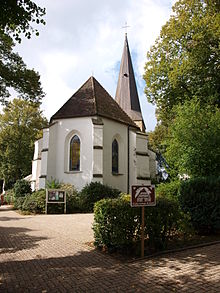St. Marien (Menslage)
St. Marien is the Evangelical Lutheran church in the center of Menslage in the Osnabrück district in Lower Saxony . The Evangelical Lutheran parish of Menslage is now part of the Bramsche parish .
history
As the only church in the north of the Osnabrück region , it originally belonged to the old Saxon town of Hasegau with its center in Löningen . With the church establishment which took place Abpfarrung from the Löninger mother church, and the parish was Menslage.
The church was founded in 1247 by the Counts of Oldenburg with the permission of the Abbot of the Corvey Monastery . The church, built in early Gothic style from lawn iron stone, was initially built without a tower, which was only added later in 1579 and was used for the Ueffeln sandstone .
Around the cemetery originally laid out on the north side of the church (today laid out to the south-west), the residents built granaries from rocks that they used to store grain. The cemetery became a closed place that was only accessible through two entrances: the Andorfer and Herberger gate. When there was a risk of war, the inhabitants escaped there. Over time, the granaries lost their importance because the farmers preferred to store the valuable grain in safe places on their own farms. One of the abandoned warehouses was converted into a council warehouse, where the church council met from then on; from the others, living and working rooms emerged, mainly workshops of the Kirchhöfer and Wördener as well as a school house.
Over time, the old buildings were replaced by half-timbered buildings and the cemetery was rebuilt to the southeast of the church because the traditional space was too small. Today, these buildings and the whitewashed church enclose the church square with its triangular floor plan and form the church corner and the canteen bar.
The church building and almost all the houses at Kirchwinkel were badly damaged on April 10, 1945, in the final phase of World War II . The reconstruction, which began immediately after the end of the war, was largely carried out in the old form and dragged on until 1954. The destroyed eastern part of the church square has been modernized.
architecture
The enclosing walls of the three-bay nave of the church with their mighty buttresses were preserved after the destruction after the vaults collapsed. The substructure of the tower, which was built between 1576 and 1579, remained undamaged and the top was rebuilt in its old form. A plaque commemorates the reconstruction with the support of Lower Saxony's Prime Minister Kopf.
Inside, the four-part vaults with pear rod ribs in the old form on wall templates with suspended corner services were renewed, but painted dark red. The pillars between the yokes are framed by three-quarter columns.
Only a fragment of the Bentheim baptismal font from the 13th century, which is now in the Bersenbrück district museum, has been preserved from the old furnishings . The oak pulpit from 1958 is from Professor Rickert, who works at the Bielefelder Kunstgewerbeschule, the steel cross from 1970 by Joachim Schulz.
The new wooden organ gallery was supplemented in 2003 with new choir windows by the Hattingen artist Egon Stratmann . They show from the left: Good Samaritan, Maria and Martha. The organ comes from Orgelbau Kemper , Lübeck and has 22 registers.
literature
- Erich Wobbe: 800 years of Menslage in Artland. In: Heimat-Jahrbuch Osnabrücker Land 1988. pp. 38–44.
Coordinates: 52 ° 40 ′ 32.6 ″ N , 7 ° 49 ′ 1.6 ″ E


